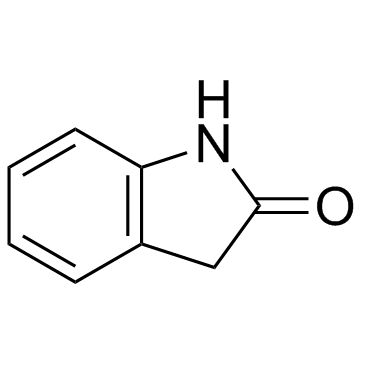Oxindole

Oxindole structure
|
Common Name | Oxindole | ||
|---|---|---|---|---|
| CAS Number | 59-48-3 | Molecular Weight | 133.147 | |
| Density | 1.3±0.1 g/cm3 | Boiling Point | 312.8±45.0 °C at 760 mmHg | |
| Molecular Formula | C8H7NO | Melting Point | 123-128 °C(lit.) | |
| MSDS | Chinese USA | Flash Point | 190.0±18.0 °C | |
| Symbol |

GHS07 |
Signal Word | Warning | |
|
Cytotoxic and antimicrobial evaluations of novel apoptotic and anti-angiogenic spiro cyclic 2-oxindole derivatives of 2-amino-tetrahydroquinolin-5-one.
Arch. Pharm. (Weinheim) 348(2) , 113-24, (2015) A novel series of cyclic 2-oxindole derivatives incorporating 2-amino-tetrahydroquinolin-5-one were prepared. The structures of the prepared compounds were elucidated using different spectral tools. The regio-orientation of the reaction products was elucidate... |
|
|
Synthesis and biological evaluation of new pyridone-annelated isoindigos as anti-proliferative agents.
Molecules 19(9) , 13076-92, (2014) A selected set of substituted pyridone-annelated isoindigos 3a-f has been synthesized via interaction of 5- and 6-substituted oxindoles 2a-f with 6-ethyl-1,2,9-trioxopyrrolo[3,2-f]quinoline-8-carboxylic acid (1) in acetic acid at reflux. Among these isoindigo... |
|
|
Synthesis and receptor binding assay of indolin-2-one derivatives as dopamine D4 receptor ligands.
Pharmazie 70 , 511-4, (2015) Five indolin-2-one derivatives bearing piperazinylbutyl side chains attached to the amide nitrogen were synthesized from 2-indolinone. 1-(4-Bromobutyl)-indolin-2-one was reacted with 1-piperazinecarboxaldehyde to form 1-(4-(4-formyl-1-piperazinyl)butyl)indoli... |
|
|
Identification and Testing of Novel CARP-1 Functional Mimetic Compounds as Inhibitors of Non-Small Cell Lung and Triple Negative Breast Cancers.
J. Biomed. Nanotechnol. 11 , 1608-27, (2015) The triple negative breast cancer (TNBCs) and non-small cell lung cancers (NSCLCs) often acquire mutations that contribute to failure of drugs in clinic and poor prognosis, thus presenting an urgent need to develop new and improved therapeutic modalities. Her... |
|
|
Construction of spiro-fused 2-oxindole/α-methylene- γ-butyrolactone systems with extremely high enantioselectivity via indium-catalyzed amide allylation of N-methyl isatin.
Org. Lett. 15(24) , 6182-5, (2013) A remarkably effective method allowing an extremely high enantioselective synthesis of the spiro-fused 2-oxindole/α-methylene-γ-butyrolactones is described. The key strategy lies in the use of indium-catalyzed asymmetric amide allylation of N-methyl isatin wi... |
|
|
Asymmetric assembly of 2-oxindole and α-angelica lactone units to construct vicinal quaternary chiral centers.
Chem. Commun. (Camb.) 48(18) , 2439-41, (2012) The first organocatalytic asymmetric assembly of Morita-Baylis-Hillman carbonates of isatins and α-angelica lactone has been studied, affording multifunctional products containing two valuable pharmacophores and vicinal quaternary chiral centers in high stere... |
|
|
Plasma and brain levels of oxindole in experimental chronic hepatic encephalopathy: effects of systemic ammonium acetate and L-tryptophan.
Pharmacol. Toxicol. 85(3) , 138-43, (1999) It has previously been shown that the neurodepressant L-tryptophan metabolite oxindole is increased in the blood and brain of rats with fulminant hepatic failure and in the blood of cirrhotic patients affected by chronic hepatic encephalopathy. In the present... |
|
|
Oxindole in pathogenesis of hepatic encephalopathy.
Lancet 351(9119) , 1861, (1998)
|
|
|
Crystal structure of a conformation-selective casein kinase-1 inhibitor.
J. Biol. Chem. 275 , 20052-20060 , (2000) Members of the casein kinase-1 family of protein kinases play an essential role in cell regulation and disease pathogenesis. Unlike most protein kinases, they appear to function as constitutively active enzymes. As a result, selective pharmacological inhibito... |
|
|
Inhibition of transforming activity of the ret/ptc1 oncoprotein by a 2-indolinone derivative.
Int. J. Cancer 85(3) , 384-90, (2000) ret-derived oncogenes are frequently and specifically expressed in thyroid tumors. In contrast to the ret receptor, ret oncoproteins are characterized by ligand-independent tyrosine-kinase activity and tyrosine phosphorylation. In this study, novel synthetic ... |